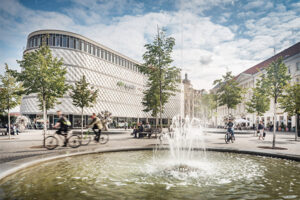BY GREGORY FONSECA
Through it all, one striking theme concerns me—that we Europeans are injecting self-imposed complexities or failing to address historically arcane procedures in our consultation processes for design and build schemes. These complexities lead to inherently long delivery cycles, which not only hinder our industry’s productivity and throughput, but, in some cases, result in incoherent outputs and a drain on the general economic climate. At a time when industries are accelerating their pace and reinventing themselves to take advantage of new technologies, perhaps it is the time to consider practical ways to streamline more of our industry’s processes to contribute to economic growth more effectively.
In Europe, and the UK in particular, the design process for town centers and city-center urban regeneration schemes is especially protracted. These mainly retail-led developments require extensive consultation processes resembling a minefield through which architects and a myriad of professionals must navigate among multiple stakeholders to acquire planning permission. These consultation processes on complicated regeneration schemes may last months, sometimes years, often being counterproductive to overall development and economic growth.
At the outset of the design process, a developer must be prepared to engage with a multitude of stakeholders, both statutory and non-statutory. Once the design concept meets a client’s brief, site constraints, national planning policy, and local policy where required, the design team then embarks on the consultation process. While the process has a general order, the ordering often takes on a life of its own. Meeting with local planning officers is the first point of contact to establish a dialogue and acquire a general consensus regarding initial urban design principals and objectives. In parallel, discussions with local highway authorities and other applicable governmental departments must also occur. As an example, added density and traffic will affect the local traffic and the infrastructure’s capacity must be tested to ensure the plan’s feasibility. Ultimately, planning officers will either support a scheme and/or request changes to meet national or local planning policies as well as economic, social, and environmental requirements for the development. In contrast, other parts of the world, like North America, have established zoning regulations that predefine the acceptable parameters of what is permitted, whether it be mass, height, uses, or maximum area, to mention just a few of the key constraints. As long as these parameters are met, design becomes a collaboration of the client’s and architect’s creativity and budget. Having these defined parameters provides a clear roadmap for development, consistent application of rules, and definable planning times.
Depending on the position of the proposed project within the town center and its juxtaposition to heritage assets, consultation with bodies like Historic England in the United Kingdom may be required. Historic England, officially named the Historic Buildings and Monuments Commission for England, is an executive, non-departmental public body tasked with protecting and preserving listed historic buildings, ancient monuments, and advising central and local government. The design team is held accountable for crafting a scheme that secures the preservation and enhancement of the man-made heritage of England for the benefit of future generations. The objective for the design team is to provide clear and convincing justification for any impact, no matter how slight, by the project’s physical presence or changes to the setting. While Historic England is not a direct approver of an application, it must ultimately support the proposed project for a scheme to progress.
The phrase “community engagement” causes considerable confusion, for it is often used as an umbrella term to cover the whole range of public involvement and consultation. In practice, it does have precise meaning referring to those actions and processes that take place to establish an effective relationship with individual and organizational stakeholders. Engaging the community at all levels is crucial to a successful planning application, since an application’s final decision on such projects is made by a development committee comprised of elected individuals whose responsibility is to those who elected them, both individuals and organizational stakeholders.
In theory, effective consultation enables such decisions and plans to be approved in the knowledge that stakeholders and the public normally have had a full opportunity to express their views and make representations in a genuine and transparent dialogue. What has been absent in the past is a sufficiently robust framework of guidance so that planning authorities and others have sufficient knowledge to make proper decisions. While the process is intended to be all-inclusive, it sometimes leaves major planning decisions in the hands of individuals or interest groups that may not have the expertise or even the best interests of the larger community at heart.
As evidenced, the planning process in Europe can be a laborious task requiring orchestrating a consensus with a multitude of stakeholders. The process can also be time-consuming and costly. By comparison, the equivalent processes in North America allow developers to build “as a matter of right,” provided that a proposal is within the defined zoning constraints. Is it not time to re-evaluate our own processes in a way to continue to protect our heritage assets and provide a comprehensive efficient planning process?
What is your opinion on this topic? Discuss it with us! Send your opinion to opinion@across-magazine.com !






